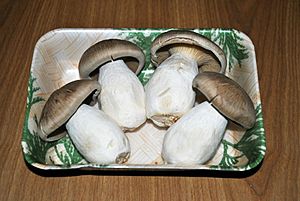Shimeji facts for kids
Shimeji (pronounced Shee-meh-jee) is a group of edible mushrooms. They are originally from East Asia, like Japan, but you can also find them in northern Europe. There are different kinds of Shimeji mushrooms. Some grow by connecting with tree roots, while others grow on dead plants. Many kinds of Shimeji are now grown on farms. These mushrooms are known for their rich, savory taste, called umami. This special taste comes from natural compounds inside the mushrooms.
Contents
Types of Shimeji Mushrooms
Many different kinds of mushrooms are sold as shimeji. Most of them grow on dead plants, but one special type, Hon-shimeji, grows with living trees.
Shimeji That Grow with Trees
- Hon-shimeji (Lyophyllum shimeji)
* This type of Shimeji is harder to grow on farms because it needs to connect with tree roots. However, some companies have found ways to grow it.
Shimeji That Grow on Dead Plants
These types of Shimeji mushrooms grow on dead wood or other plant matter. They are much easier to grow on farms.
- Buna-shimeji (Hypsizygus tessellatus)
* This mushroom is also known as the brown beech or brown clamshell mushroom. It was one of the first Shimeji types to be grown on farms in Japan, starting in 1973. Today, many different kinds of Buna-shimeji are grown and sold fresh in stores.
- Bunapi-shimeji
* This mushroom is known as the white beech or white clamshell mushroom. It was created from buna-shimeji using special methods.
- Hatake-shimeji (Lyophyllum decastes)
- Shirotamogidake (Hypsizygus ulmarius)
* These two types were sometimes sold as hon-shimeji in the past.
- Velvet pioppino (Agrocybe aegerita)
* This mushroom is also called the black poplar mushroom.
Cooking with Shimeji Mushrooms
Shimeji mushrooms should always be cooked before you eat them. If you eat them raw, they can taste a bit bitter. But when you cook them, the bitterness goes away completely! Cooked Shimeji mushrooms have a nice, firm, and slightly crunchy texture. They also have a mild, nutty flavor. Cooking them also makes them easier for your body to digest.
Shimeji mushrooms are great in many dishes:
- They work well in stir-fries.
- You can add them to dishes with wild game or seafood.
- They are also tasty in soups, stews, and sauces.
When cooking Shimeji by themselves, you can sauté them whole. Just cut off the very end of the stem. You can cook them quickly at a higher temperature or slowly roast them with a little butter or cooking oil. In Japan, Shimeji are often used in soups, hot pot dishes called nabe, and mixed rice dishes called takikomi gohan.
See also
 In Spanish: Shimeji para niños
In Spanish: Shimeji para niños




